Cervical cancer epidemiology and screening results
Czech Republic
The Czech National Cancer Registry (CNCR) is the main source of data on cancer epidemiology in the Czech Republic. CNCR has become an integral part of comprehensive cancer care, containing more than 3 million records from the period 1977–2022 and covering 100% of the Czech population. Registration of malignant tumours is stipulated by law and is obligatory [1]. CNCR data is publicly available on the website www.svod.cz [2].
-
Cervical cancer incidence and mortality rates
Cervical cancer is a relatively common type of cancer in women worldwide, affecting young women in many cases. Each year, around 760 women are diagnosed with cervical cancer in the Czech Republic, and there are nearly 300 deaths from cervical cancer among Czech women. Both incidence and mortality trends have mostly stagnated in the entire monitored period; a slight decrease has been observed only recently Fig. 1a. In 2022, there were 716 new cases of cervical cancer, corresponding to more than 13 cancers per 100,000 women in the Czech population. In the same year, there were 274 cervical cancer deaths among women in the Czech Republic, corresponding to 5 cervical cancer deaths per 100,000 women in the Czech population.
Apart from absolute numbers of newly diagnosed cases and deaths per year (Fig. 1a), cervical cancer incidence and mortality rates can be recalculated per 100,000 women in the population (Fig. 1b) or standardized on a certain age standard; the most common ones include the age-standardized world rate (ASR-W, Fig. 1c) and the new age-standardized European rate (ASR-E 2013, Fig. 1d). Such recalculations make it possible to compare cervical incidence and mortality rates with those of other countries (see more details in the International comparison tab). Recalculation by ASR-E shows that in the period 2007–2017 in the Czech Republic, cervical cancer mortality decreased by 14% and cervical cancer incidence decreased by as much as 25%.
Figure 1a: Absolute numbers of new cases / deaths. Data source: CNCR (incidence in the entire period, mortality up to 1993), CZSO (mortality since 1994).
Figure 1c: Age-standardized world rates (ASR-W). Data source: CNCR (incidence in the entire period, mortality up to 1993), CZSO (mortality since 1994).
-
Cervical cancer prevalence rates
A slight decrease in mortality rates has been observed only recently (see above). More or less stable incidence rates, however, have inevitably led to an increase in prevalence rates, i.e. the number of cervical cancer survivors. However, a slight decrease in incidence rates in recent years has led to a recent stagnation in prevalence rates. In 2022, the prevalence of patients with a history of cervical cancer reached 17,694, corresponding to a nearly 3% increase in comparison with 2008 (17,248 cervical cancer survivors) (Fig. 2a).
-
Clinical stages
It is widely known that a cancer diagnosed at an early stage (or even at the stage of precancerous changes) is much more likely to be treated successfully and that the chance of survival in such cases is much higher. In 2022, a total of 2,768 cases of cervical cancer were detected in the in-situ stage (D06), which has undoubtedly had a favourable effect on incidence and mortality trends of the C53 diagnosis. On top of that, the proportion of carcinomas in situ has been growing over time, mainly due to preventive measures that had been adopted earlier. On the other hand, available population-based data show that the proportion of advanced stages in newly diagnosed cases of cervical cancer is more or less stable (Fig. 3a). In 2022, nearly 35% of new cases of cervical cancer were diagnosed at advanced stages III or IV. Fig. 3b shows trends in cervical cancer incidence rates when taking into account the stage at which the disease is diagnosed.
-
Age structure of patients
Cervical cancer typically affects women in working age. About two thirds of cervical cancer patients are aged 20–64 years and 31% of all patients are under the age of 45 (Fig. 4a). Fig. 4b shows the profile of age-specific incidence rates for cervical cancer.
-
References
- Institute of Health Information and Statistics of the Czech Republic: Czech National Cancer Registry (CNCR) [16 July 2024]. Available from WWW: http://www.uzis.cz/registry-nzis/nor
- 2. Krejčí Denisa, Mužík Jan, Šnábl Ivo, Gregor Jakub, Komenda Martin, Dušek Ladislav. Portal of Cancer Epidemiology in the Czech Republic [online]. Masaryk University, Brno, 2024. [cit. 2024-07-16]. Available from: https://www.svod.cz/en/. Version 8.0.0
International comparison
Cervical cancer is among the most commonly diagnosed cancers in women worldwide. In 2020, according to the GLOBOCAN estimates [1], there were 604,127 new cases of cervical cancer worldwide (4th most common cancer in women worldwide, accounting for 6.9% of all cancers in women apart from non-melanoma skin cancers), and 58,169 new cases of cervical cancer in Europe (9th most common cancer in women in Europe, accounting for 3.0% of all cancers in women apart from non-melanoma skin cancers). In 2020, there were an estimated 341,831 deaths from cervical cancer worldwide (7.8% of the total number of cancer deaths in women, 4th most common cause of cancer-related deaths in women), and 25,989 deaths from cervical cancer in Europe (3.0% of the total number of cancer deaths in women, 10th most common cause of cancer-related deaths in women). The 5-year prevalence of cervical cancer (i.e., the number of cervical cancer patients who were still alive five years after diagnosis) in 2020 was estimated at 1,495,211 worldwide (38.7 cervical cancer survivors per 100,000 women) and 172,721 in Europe (44.6 cervical cancer survivors per 100,000 women). In 2020, the cumulative risk of cervical cancer in women aged under 75 was 1.39% worldwide and 1.03% in Europe [1].
-
Basic overview of epidemiological characteristics
Tables 1 and 2 provide a basic overview of epidemiological characteristics of cervical cancer worldwide and in Europe.
Table 1: Epidemiology of cervical cancer worldwide. Source: GLOBOCAN 2020.
Parameter Women Incidence rates
number of new cases
604,127
number of new cases per 100,000 women
15.6
ASR(W)
13.3
proportion of all newly diagnosed cancers (apart from skin cancers)
6.9%
rank among all newly diagnosed cancers (apart from skin cancers)
4th
Mortality rates
number of deaths
341,831
number of deaths per 100,000 women
8.8
ASR(W)
7.3
proportion of all cancer-related deaths (apart from skin cancers)
7.8%
rank among all cancer-related deaths
4th
Prevalence rates (patients still alive five years after diagnosis)
absolute number of survivors
1,495,211
rate per 100,000 women
38.7
Cumulative risk of developing cervical cancer
from birth until the age of 75
1.39%
Table 2: Epidemiology of cervical cancer in Europe. Source: GLOBOCAN 2020.
Parameter Women Incidence rates
number of new cases
58,169
number of new cases per 100,000 women
15.0
ASR(W)
10.7
proportion of all newly diagnosed cancers (apart from skin cancers)
3.0%
rank among all newly diagnosed cancers (apart from skin cancers)
9th
Mortality rates
number of deaths
25,989
number of deaths per 100,000 women
6.7
ASR(W)
3.8
proportion of all cancer-related deaths (apart from skin cancers)
3.0%
rank among all cancer-related deaths
10th
Prevalence rates (patients still alive five years after diagnosis)
absolute number of survivors
172,721
rate per 100,000 women
44.6
Cumulative risk of developing cervical cancer
from birth until the age of 75
1.03%
-
Incidence and mortality
Czech cervical cancer incidence rates rank 132nd worldwide and 23rd in Europe, while Czech cervical cancer mortality rates rank 135th–137th worldwide and 16th–17th in Europe.
Figure 1: International comparison of cervical cancer (C53) incidence rates. ASR(W) – age-standardised world incidence rate per 100,000 women. Source: GLOBOCAN 2020 [1].
-
Prevalence and M/I ratio
International epidemiological statistics make it possible to estimate the ratio of mortality to incidence rates (M/I), which can be considered as an indirect indicator of survival of cervical cancer patients in a given country (Figure 3). According to the most recent statistics [1], the Czech Republic with its M/I ratio at 0.39 ranks 12th in Europe. Recent data from the Czech National Cancer Registry [2], i.e. the incidence of 9.00 and the mortality of 3.03 (data from 2018 recalculated as ASR-W), give the ratio of 0.34.
Internationally assessed prevalence rates (i.e., number of patients still alive five years after diagnosis) are shown in Figure 4. As a logical consequence, the highest prevalence rates have been reported for countries with the lowest values of M/I ratio. As for cervical cancer prevalence rates, the Czech Republic is close to the European average.
Figure 3: International comparison of the ratio of mortality to incidence rates (M/I), cervical cancer (C53). Evaluated according to ASR(W) – age-standardised world incidence rate per 100,000 women. Source: GLOBOCAN 2020 [1].
-
Cumulative risk
Let us conclude this overview of international statistics with a summary of cumulative risk of cervical cancer in women from birth until the age of 75 (Figure 5). Cumulative risk for the Czech Republic is 1.31, so the Czech female population occupies the 20th position in Europe and the 130th position globally.
-
References
- 1. Ferlay J, Ervik M, Lam F, Colombet M, Mery L, Piñeros M, Znaor A, Soerjomataram I, Bray F (2020). Global Cancer Observatory: Cancer Today. Lyon, France: International Agency for Research on Cancer [accessed on 1 March 2021]. Available from WWW: https://gco.iarc.fr/today.
- Dušek L., Mužík J., Kubásek M., Koptíková J., Žaloudík J., Vyzula R. Epidemiology of malignant tumours in the Czech Republic [online]. Masaryk University, Brno (Czech Republic) [2005] [accessed on 1 March 2021]. Available from WWW: http://www.svod.cz. Version 7.0 [2007], ISSN 1802-8861.
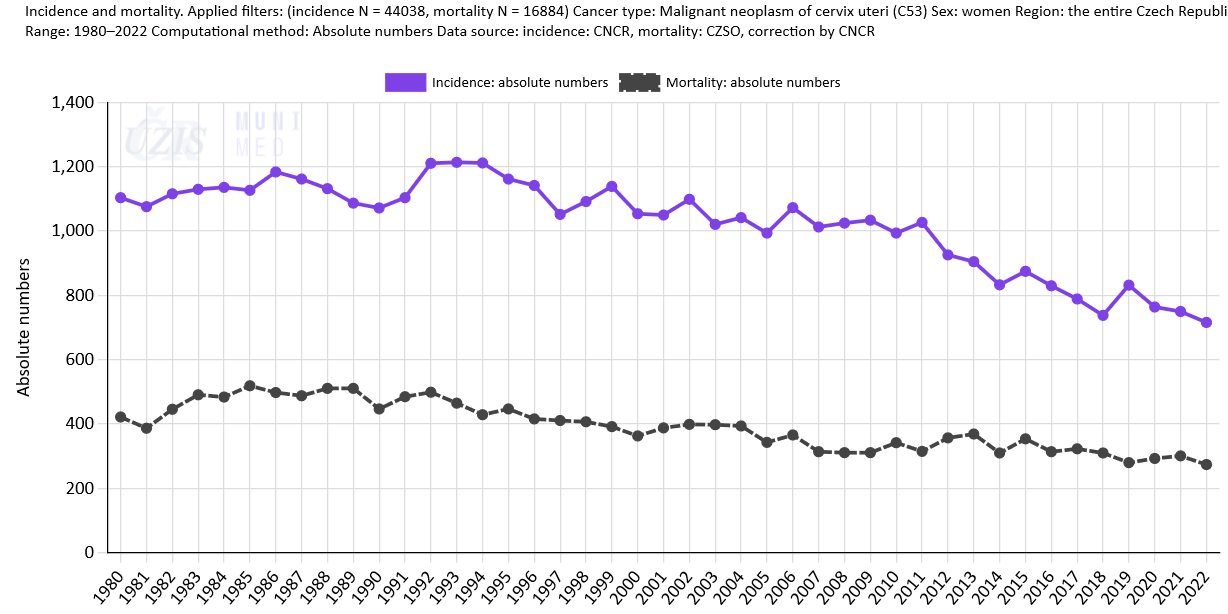
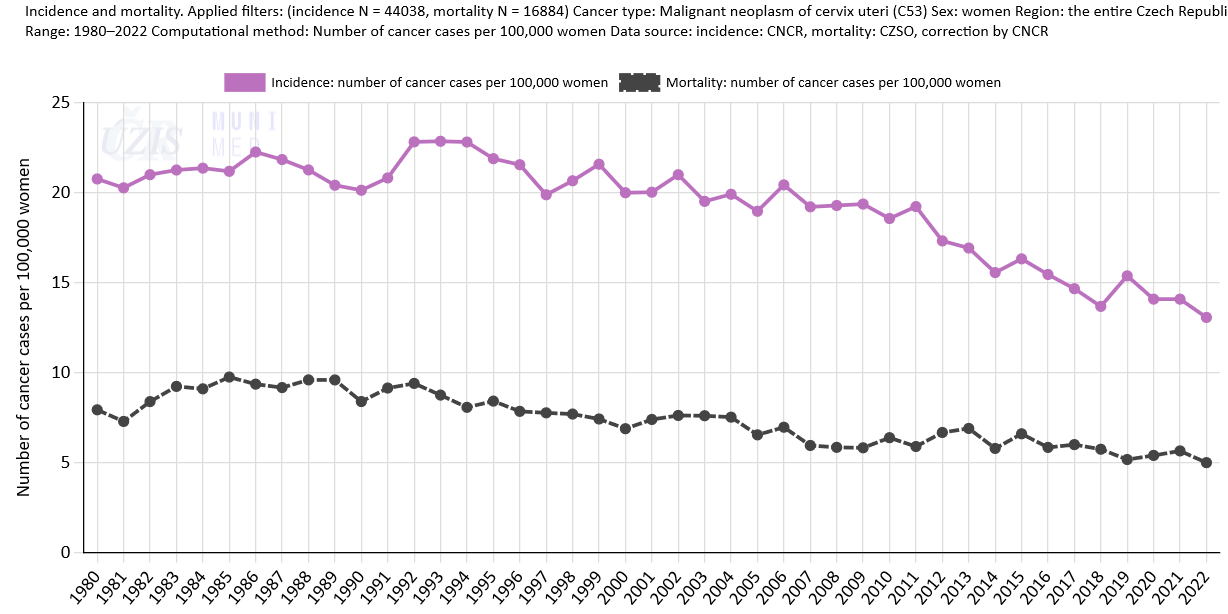
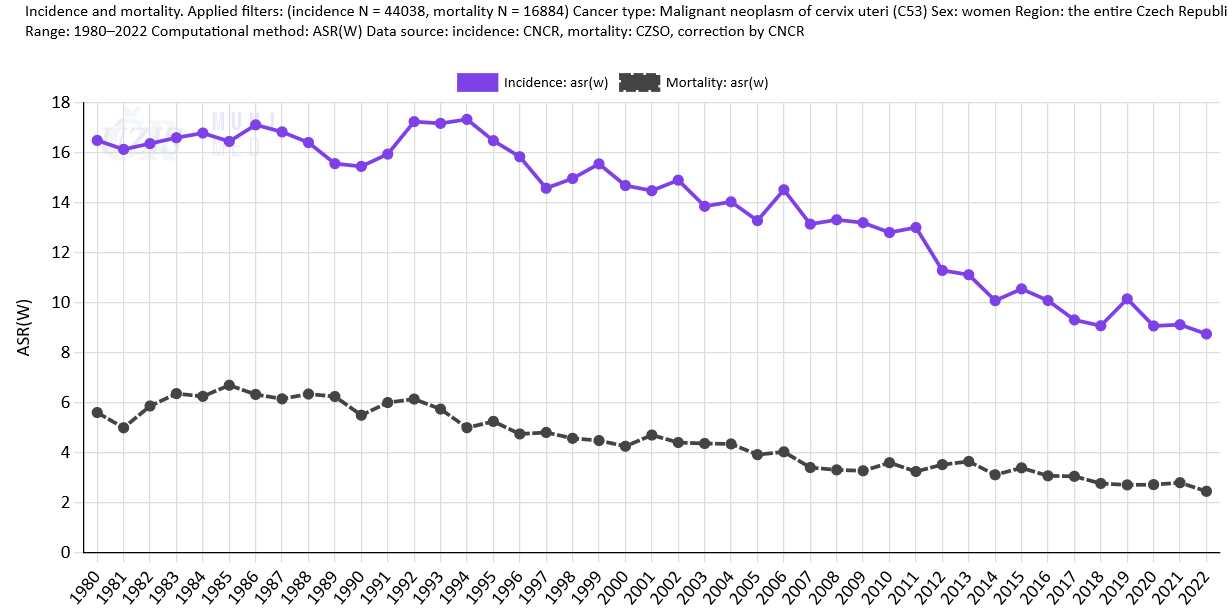
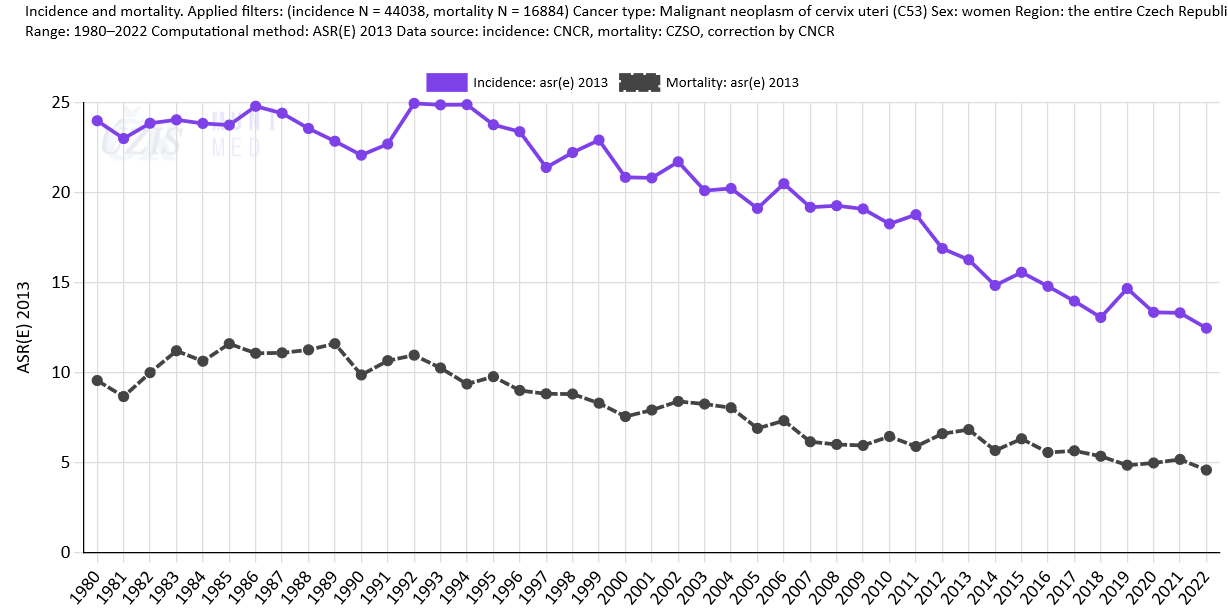
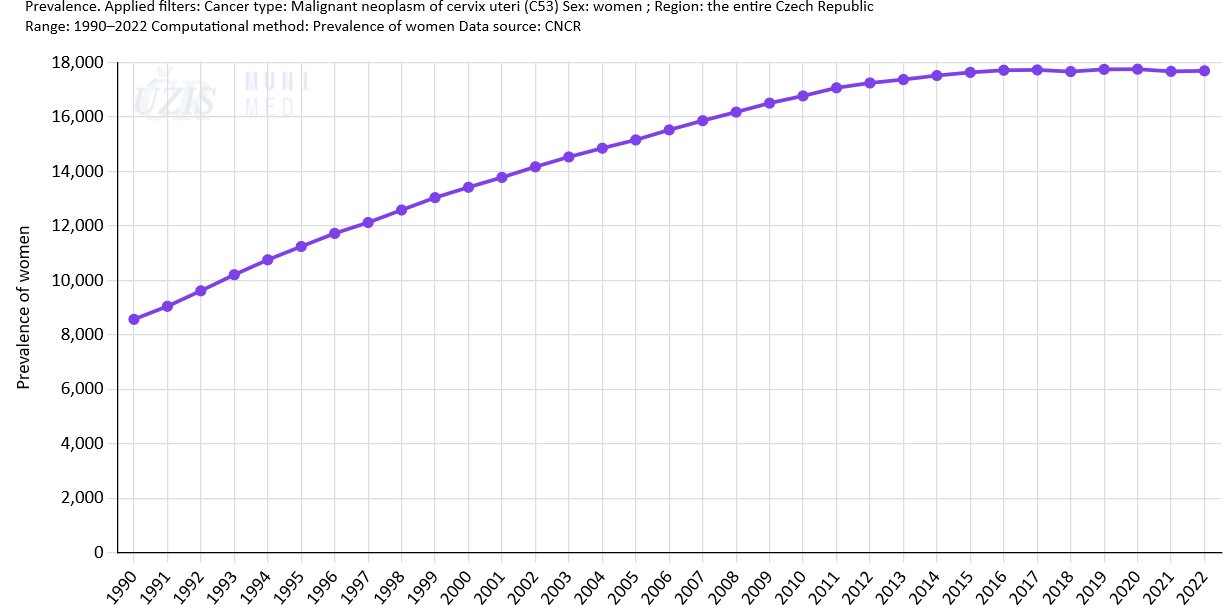
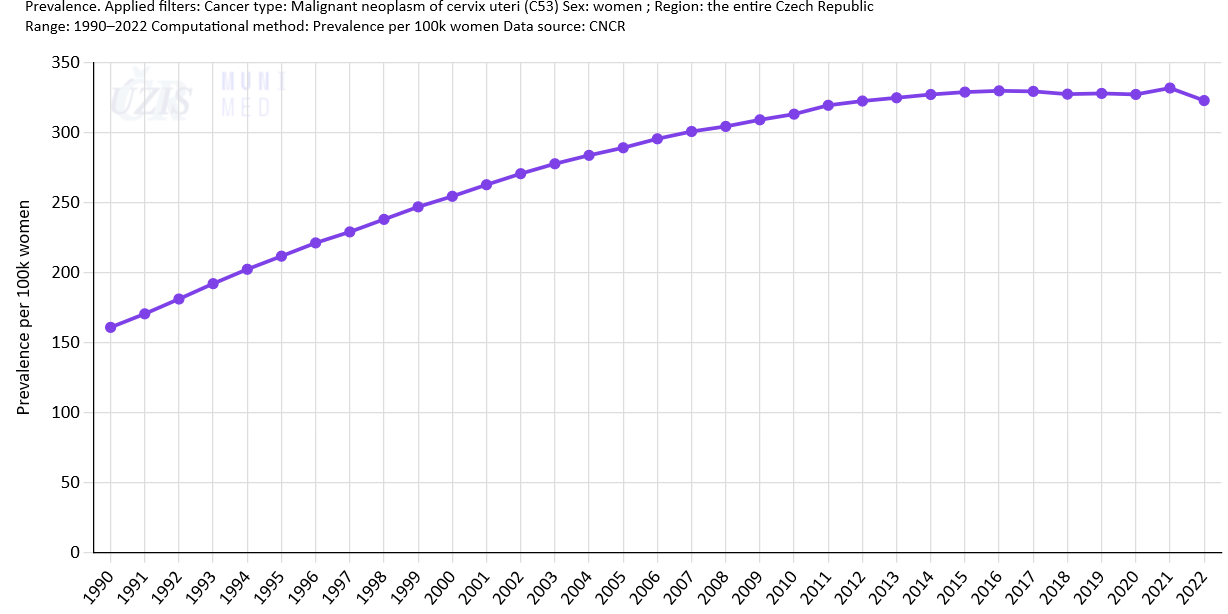
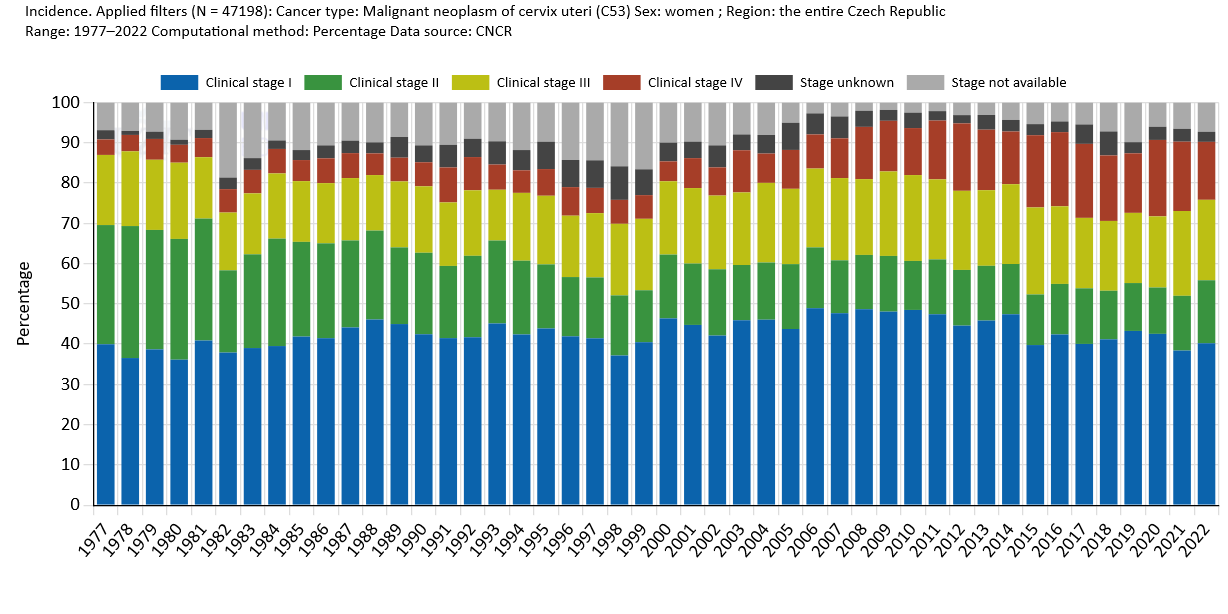
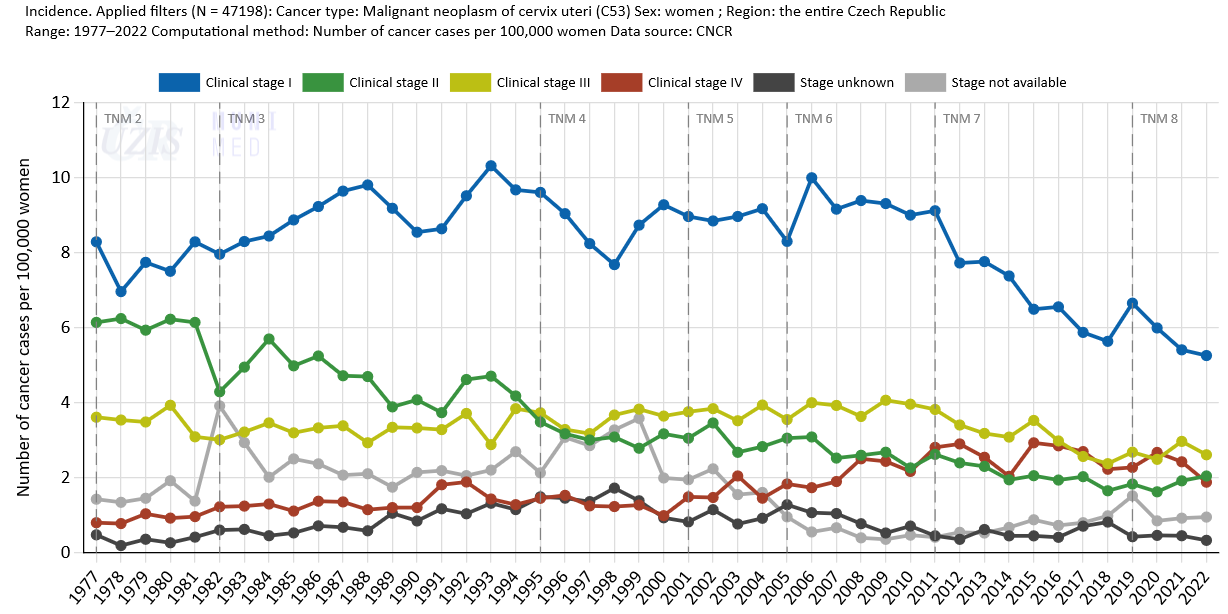
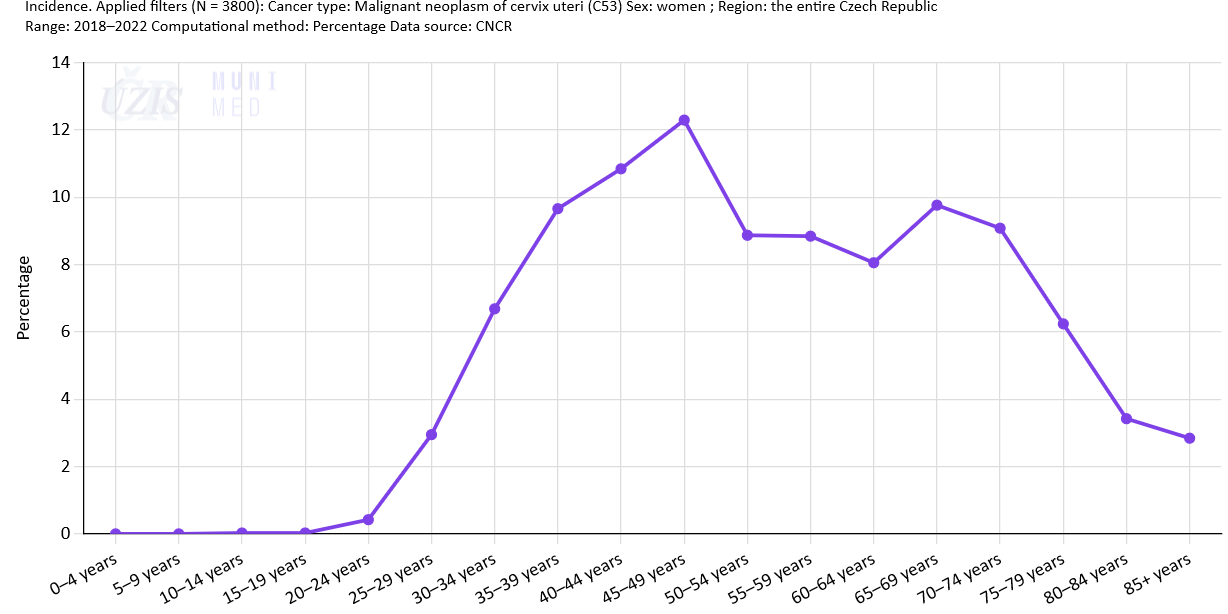
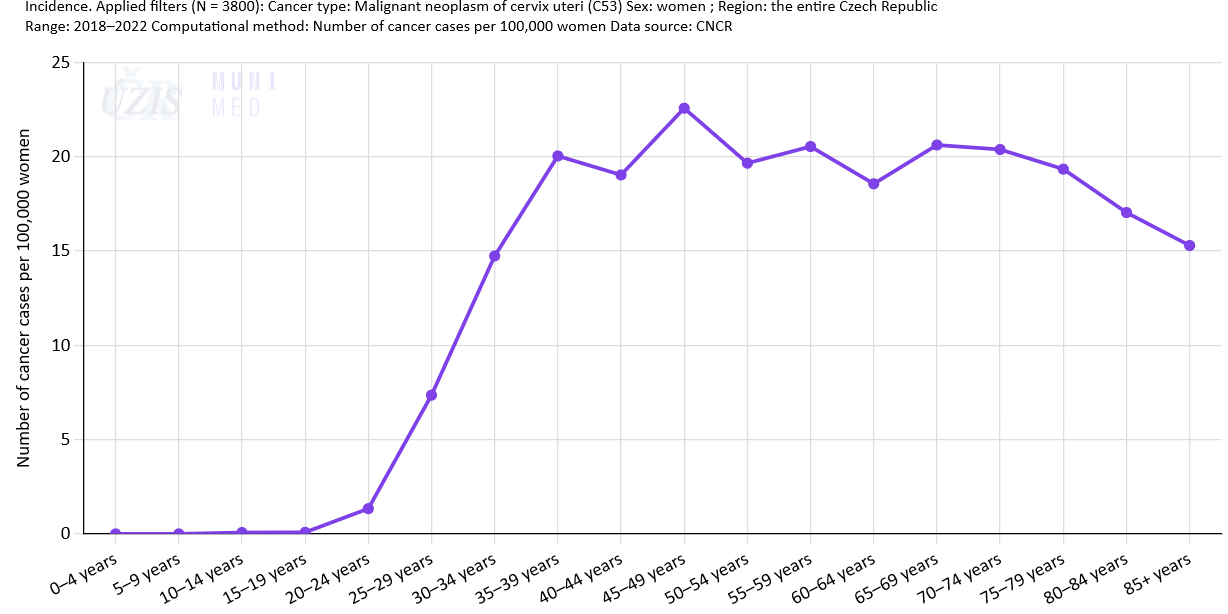
![Figure 1: International comparison of cervical cancer (C53) incidence rates. ASR(W) – age-standardised world incidence rate per 100,000 women. Source: GLOBOCAN 2020 [1]. Figure 1: International comparison of cervical cancer (C53) incidence rates. ASR(W) – age-standardised world incidence rate per 100,000 women. Source: GLOBOCAN 2020 [1].](/res/image/epidemiology/033-cervical-cancer-incidence-women.png)
![Figure 2: International comparison of cervical cancer (C53) mortality rates. ASR(W) – age-standardised world mortality rate per 100,000 women. Source: GLOBOCAN 2020 [1]. Figure 2: International comparison of cervical cancer (C53) mortality rates. ASR(W) – age-standardised world mortality rate per 100,000 women. Source: GLOBOCAN 2020 [1].](/res/image/epidemiology/036-cervical-cancer-mortality-women.png)
![Figure 3: International comparison of the ratio of mortality to incidence rates (M/I), cervical cancer (C53). Evaluated according to ASR(W) – age-standardised world incidence rate per 100,000 women. Source: GLOBOCAN 2020 [1]. Figure 3: International comparison of the ratio of mortality to incidence rates (M/I), cervical cancer (C53). Evaluated according to ASR(W) – age-standardised world incidence rate per 100,000 women. Source: GLOBOCAN 2020 [1].](/res/image/epidemiology/050-cervix-mi-ratio-women.png)
![Figure 4: International comparison of cervical cancer (C53) prevalence rates (patients still alive five years after diagnosis. Source: GLOBOCAN 2020 [1]. Figure 4: International comparison of cervical cancer (C53) prevalence rates (patients still alive five years after diagnosis. Source: GLOBOCAN 2020 [1].](/res/image/epidemiology/051-cervix-5year-prevalence-women.png)
![Figure 5: International comparison of cumulative risk of cervical cancer (C53) from birth to 75 years of age. Source: GLOBOCAN 2020 [1]. Figure 5: International comparison of cumulative risk of cervical cancer (C53) from birth to 75 years of age. Source: GLOBOCAN 2020 [1].](/res/image/epidemiology/055-cervix-cumulative-risk-women.png)
